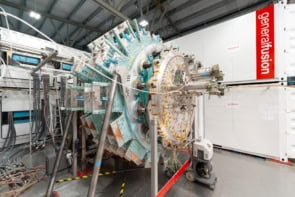
Two neutrino physicists in the US have proposed a novel way to detect the presence of weapons-grade uranium in nuclear-powered submarines without entering their reactor compartments. The procedure, which could be conducted in port while a submarine’s reactor is turned off, could help to safeguard against the diversion of highly-enriched uranium into weapons programmes.
The Treaty on the Non-Proliferation of Nuclear Weapons prohibits the transfer of nuclear material from civilian power plants – where it is monitored by the International Atomic Energy Association – to nuclear weapons. It does, however, permit its transfer to non-explosive military uses like nuclear-powered submarines and aircraft carriers. However, once nuclear material is transferred from the civilian realm to the military one, it becomes much harder to track.
Countries are unwilling to divulge the exact movements of their submarines, which makes monitoring them while they are in use impossible, and some are more secretive still. “If you forget about neutrinos, the next best proposal involves using neutron monitors – passive targets that soak up neutrons and become radioactive as a result.” explains Patrick Huber of Virginia Tech; “You place them in the reactor compartment and retrieve them while the vessel is in port. “This requires entry of an inspector into the reactor compartment, and as far as we know no foreigner ever entered the reactor compartment of a US ship.”
Pressing need
This concern has become more pressing as the US and UK have recently agreed to sell nuclear submarines to Australia – which is a non-nuclear state. Australia is unlikely to attempt to build a nuclear bomb, but the transfer of weapons-grade uranium to non-nuclear states underlines the need for a method of verifying that it is not diverted to make weapons.
Submarines can be fuelled with either highly enriched, weapons-grade uranium, which is around 90% uranium-235, or low-enriched uranium, which is mostly uranium-238. States might hypothetically therefore either simply remove highly enriched uranium from submarines or switch it out for low-enriched uranium, allowing nuclear submarines to keep operating while surreptitiously pursuing nuclear weapons programmes. “The foremost goal would be to verify that there is indeed a reactor on board the submarine and the second goal would be to check that it has been fuelled with what it says,” Huber explains.
Huber and Virginia Tech colleague Bernadette Cogswell propose using the fact that an operational nuclear reactor generates radioactive isotopes that decay with various half-lives. Almost all the neutrinos from these decays would pass straight out through the reactor compartment, and could be monitored by a detector underneath the submarine. Moreover, different types of fuel would produce different radioactive isotopes, and these might be identifiable from different neutrino signals.
Specifically, they worked out that, whereas uranium-235 is directly fissile, uranium-238 undergoes beta decay to plutonium-239 before splitting. Therefore, fission products of plutonium-239 decay would suggest that low-enriched uranium had been used in the reactor. Many radioactive isotopes are produced by the nuclear fission of both uranium-235 and plutonium-239, but two stood out for the researchers – cerium-144 and ruthenium-106, which both undergo decays that involve the emission of neutrinos.
Unique combination of decay properties
Cerium-144, which undergoes inverse beta decay with a half-life of 411 days, is produced in slightly larger quantities by uranium-235 fission than by plutonium-239 fission, whereas ruthenium-106, which undergoes inverse beta decay with a half-life of 536 days, is produced in large quantities by plutonium-239 fission but barely produced at all by uranium-235 fission. Both isotopes, if present, would be decaying continuously while a vessel was docked with the reactor switched off, producing neutrinos with different energies: “It’s not like there are 50 isotopes we could use instead,” says Huber; “It’s a fairly unique combination of properties these isotopes have.”

Neutrino-based communication is a first
Huber points out that some countries have moved to eliminate the use of highly enriched uranium from naval reactors completely, and French nuclear submarines no longer use it. One day, therefore, their test might be used to verify the absence of weapons grade uranium from a reactor compartment rather than its presence.
Neutrino physicist Jason Detwiler of the University of Washington in Seattle is impressed with the duo’s work. “Most of the non-proliferation studies using neutrinos that I’m aware of have been focused on detecting the prompt neutrinos that come out of a reactor while it’s operating”. He describes as “really interesting” the fact that the researchers have identified a pair of isotopes and a relatively novel type of neutrino detector that should be able to detect them for a year or more with relative ease, and shown that they give a signal that corresponds to the central concern for non-proliferation. “They assuaged all the difficulties that a scientist could foresee,” he says.
The research is described in Physical Review Letters.



